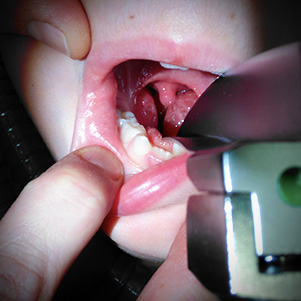Tonsillectomy in children
Tonsillectomy and adenoidectomy are the most common pediatric surgical procedures. Tonsillectomy means the surgical removal of the tonsils - paired lymphoid tissues situated on both sides of the back of your throat. These immunocompetent tissues are in the first line to defend the body against ingested or inhaled pathogens. When tonsils become enlarged or inflamed they may require a surgical removal. Indications for tonsillectomy include recurrent pharyngotonsillitis, chronic tonsillitis, hemorrhagic tonsillitis, peritonsillar abscess, streptococcal carriage, dysphagia, halitosis, and the suspicion of malignant disease.
Review
The educational algorithm very accurately describes the real clinical situation a paediatric anaesthetist is repeatedly confronted. It realistically simulates typical situations and conditions that accompany a relatively frequent diagnosis which is often downplayed, however, brings a number of serious risks even for an experienced anaesthetist. Fully in line with modern trends, current acute and intensive medicine primarily emphasizes the safety of the procedure without unnecessary restrictions to the patient. It properly takes into account the entire process from the patient´s admission to hospital through an evaluation of their current health status, an effective premedication, the administration of anaesthesia and keeping the airways unblocked up to the safe post-operative care. A decision-making algorithm is logical, enough space is dedicated to each part of the performance. It also includes a brief and clear explanation why this or that particular procedure is correct. The above mentioned model example is a copy of a real situation, that should be correctly handled by each doctor dedicated to pediatric anesthesia and intensive care. Practicing the correct procedure is the best preparation for the actual situation. Unlike making decisions according to the theoretical algorithm you usually can not “go a step back“ in real life.
Sources
LARSEN, Reinhard. Anestezie. Vyd. 2. české. Překlad Jarmila Drábková. Praha: Grada, 2004. ISBN 80-247-0476-5
KASAL, Eduard. Základy anesteziologie, resuscitace, neodkladné medicíny a intenzivní péče pro lékařské fakulty. 1. vyd. Praha: Karolinum, 2003. ISBN 80-246-0556-2
[EDITED BY] PAUL G. BARASH .. [ET AL.]. Handbook of clinical anesthesia. 7th ed. Philadelphia, PA: Lippincott Williams & Wilkins/Wolters Kluwer, 2013. ISBN 9781451176155
MOTOYAMA, Etsuro K a Peter DAVIS. Smith's anesthesia for infants and children. 7th ed. Philadelphia, Pa.: Mosby, 2006. ISBN 0323026478
Related algorithms
- Basic life support in children
- Acute laryngitis in children
- Newborn resuscitation - 2014
- Febrile seizures - 2015
- Complex regional pain syndrome in children (algoneurodystrophy)
- Anaesthesia of newborn
- Severe respiratory infection in a child
- Anaesthetic Management of Patient with Diabetes Mellitus
- Target Controlled Infusion Anaesthesia





